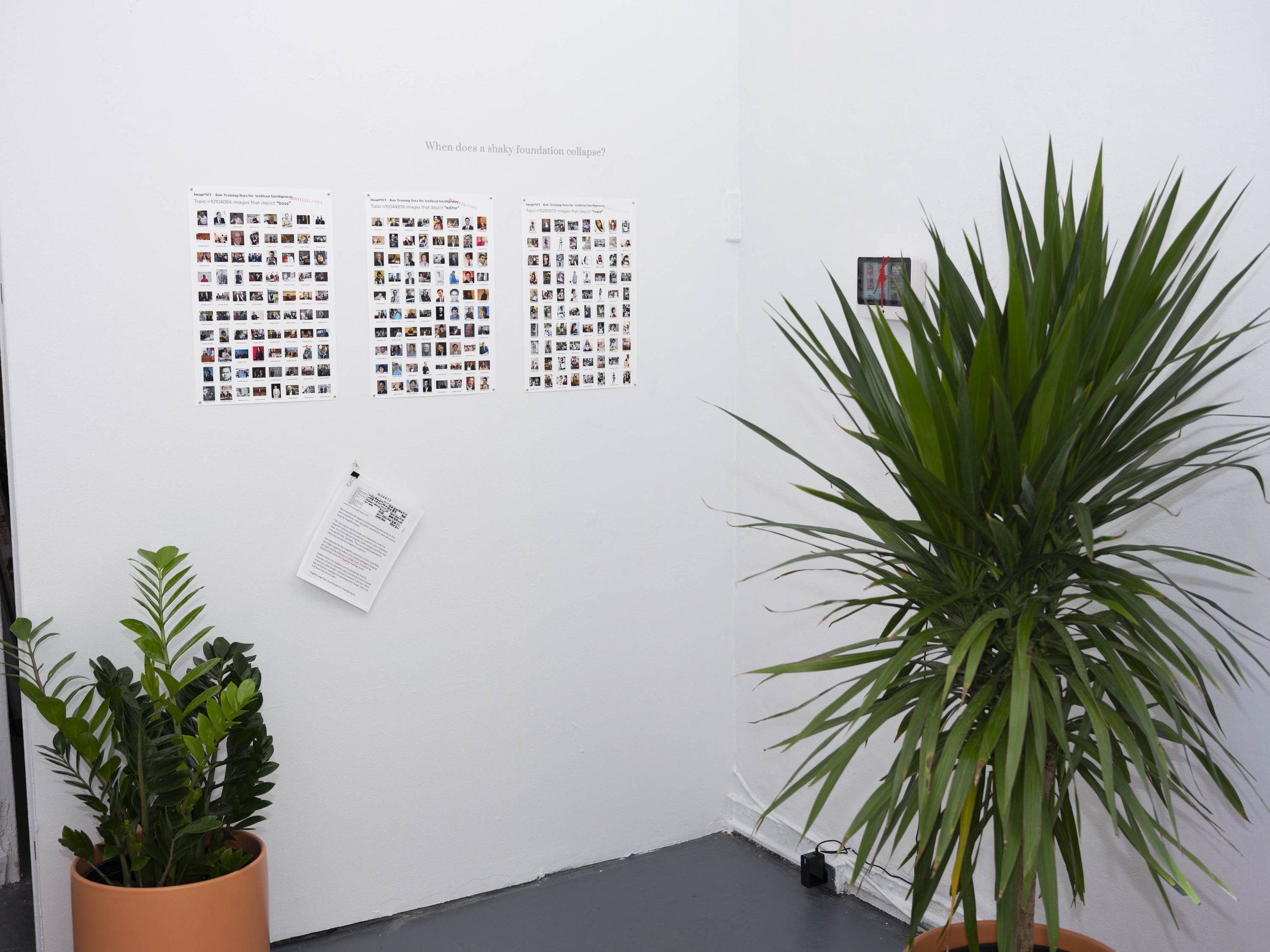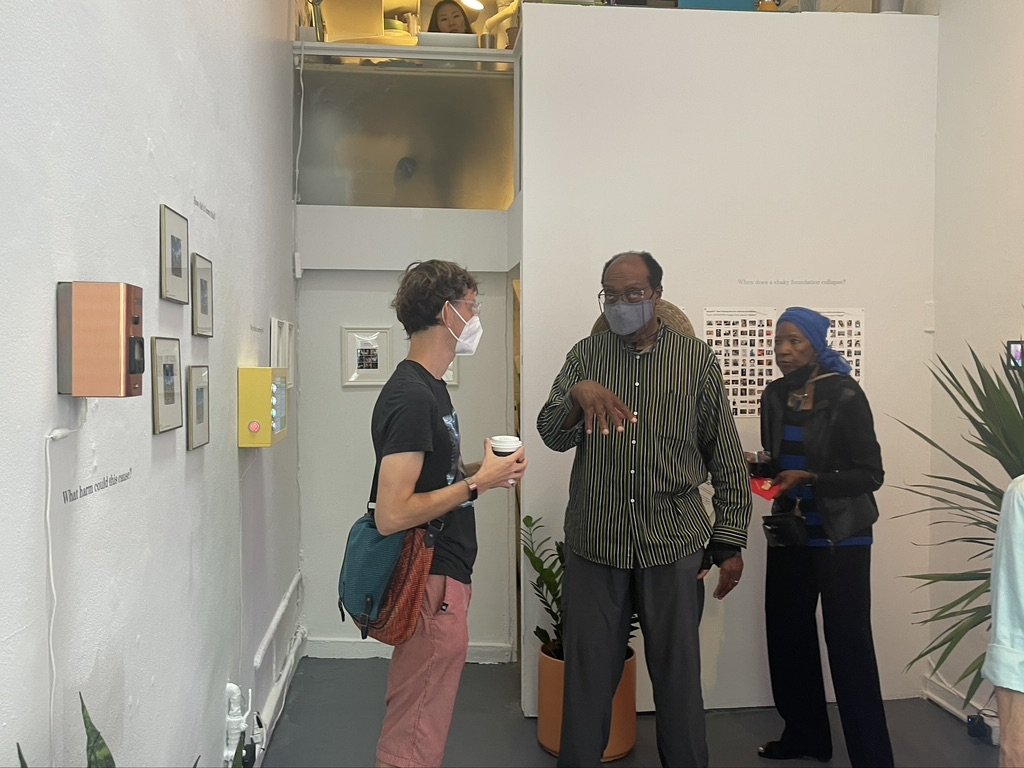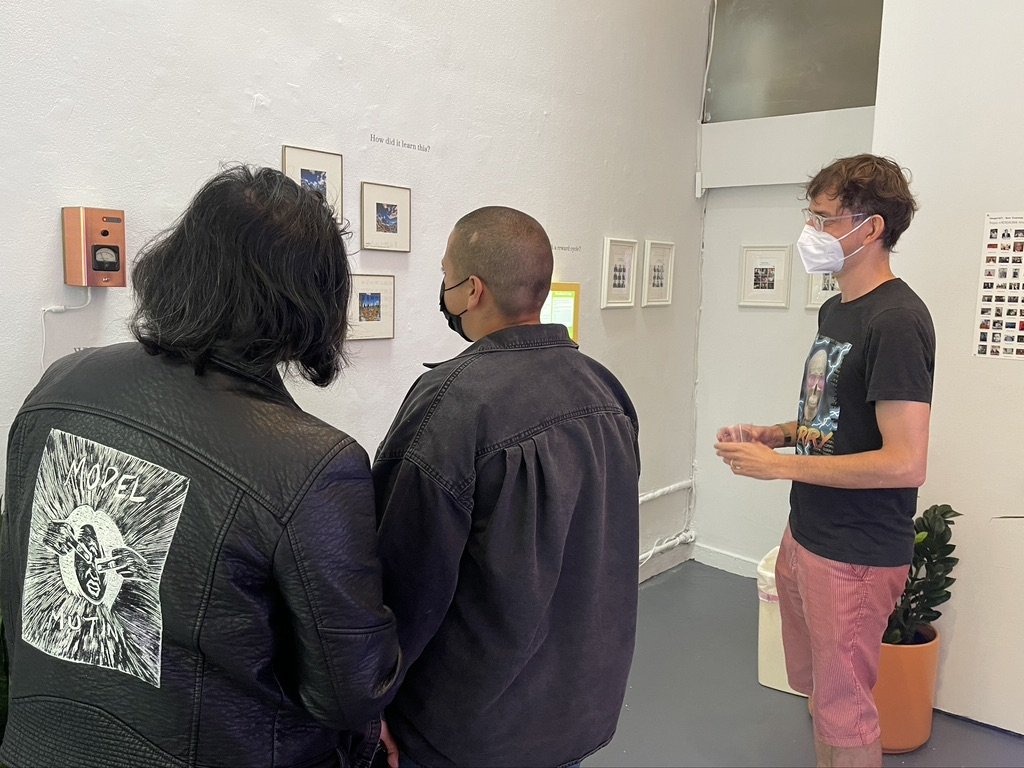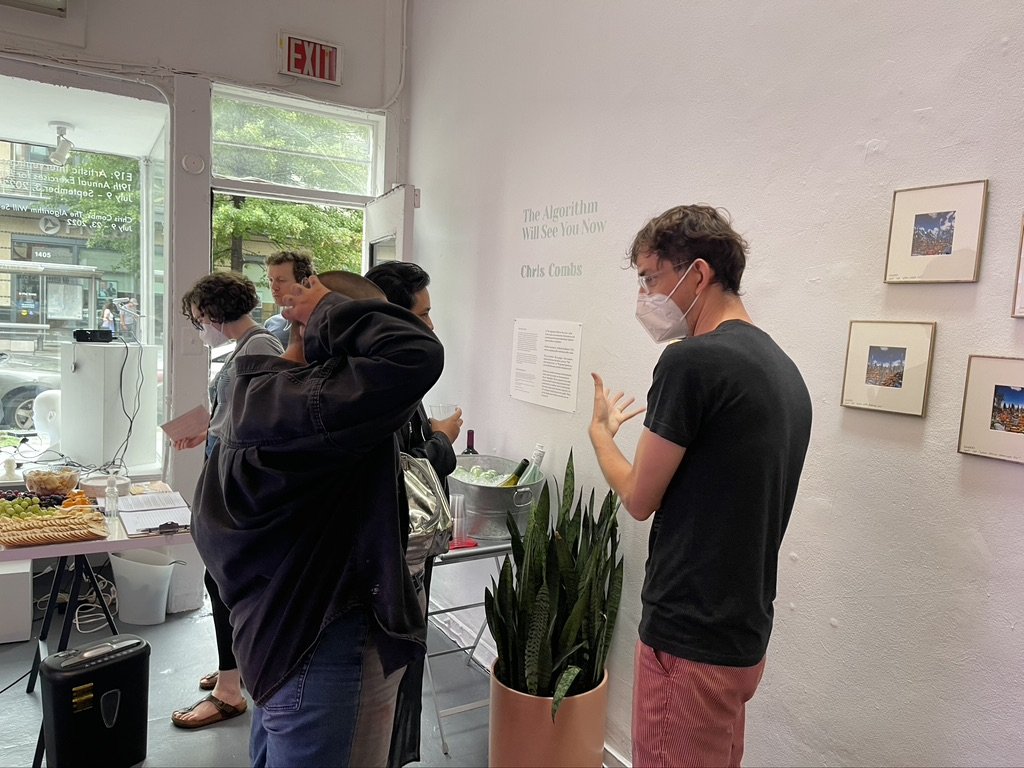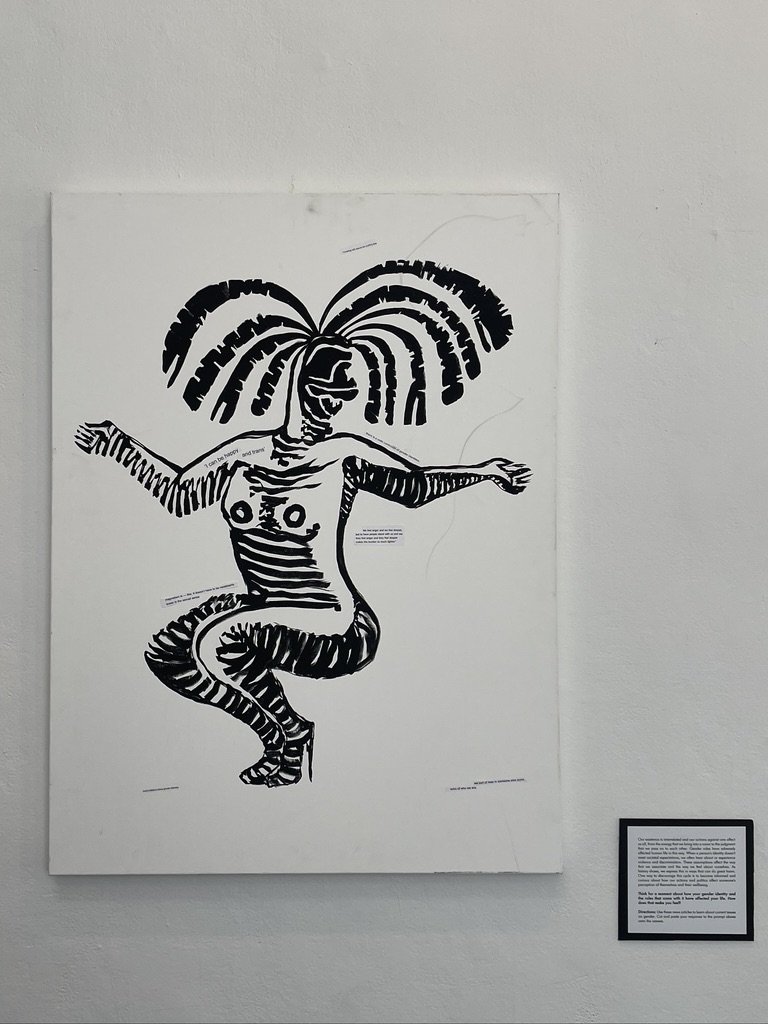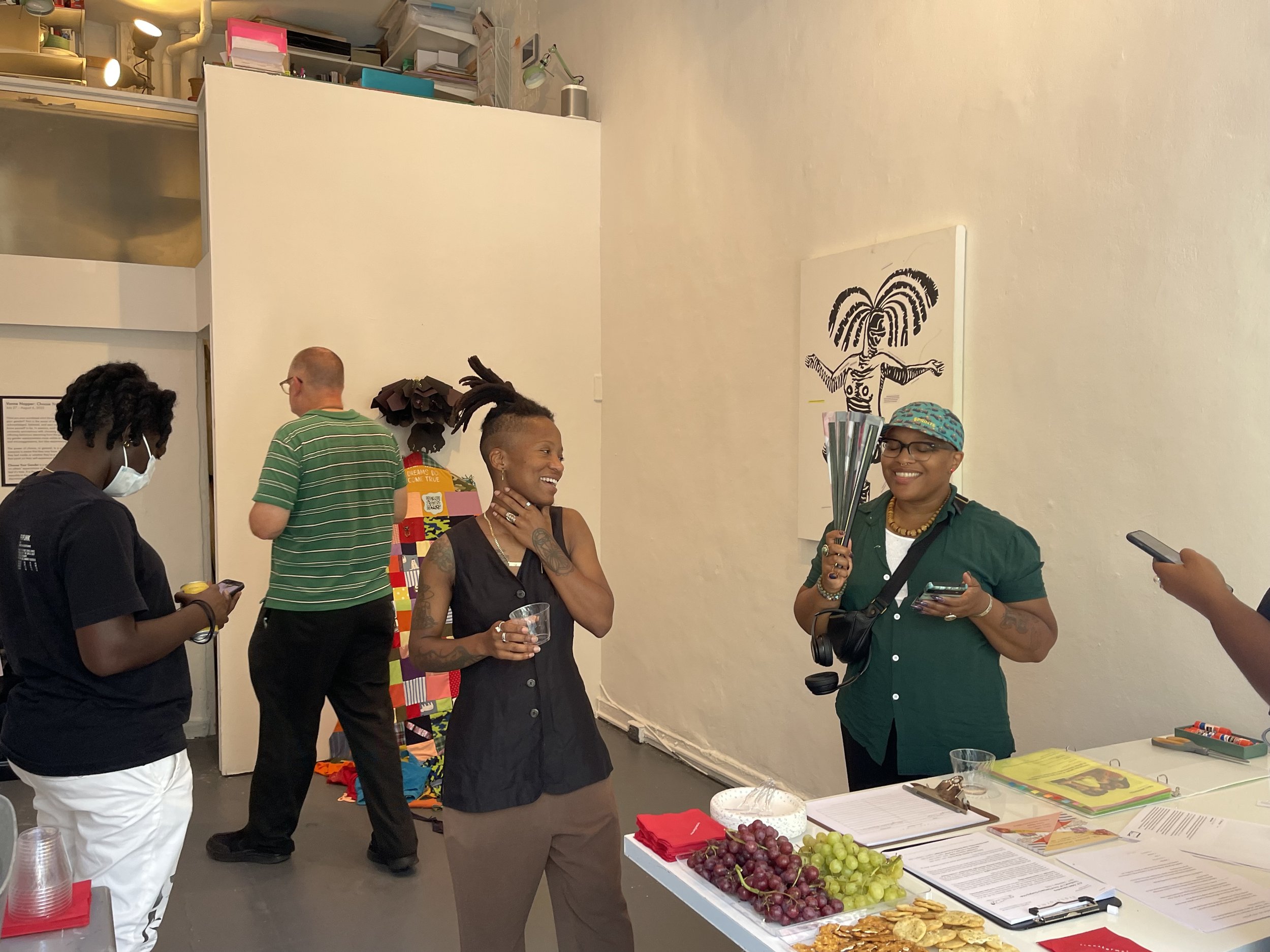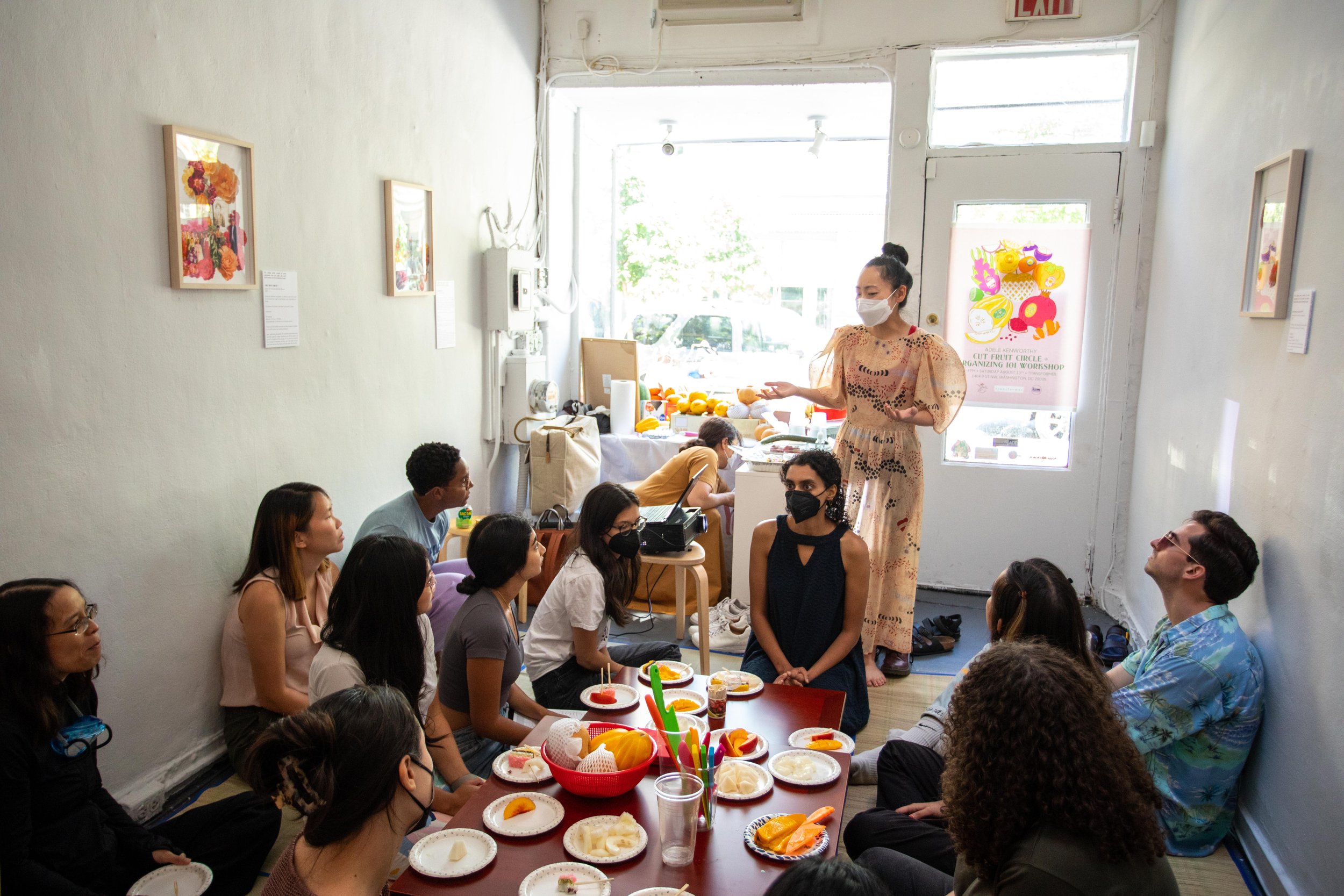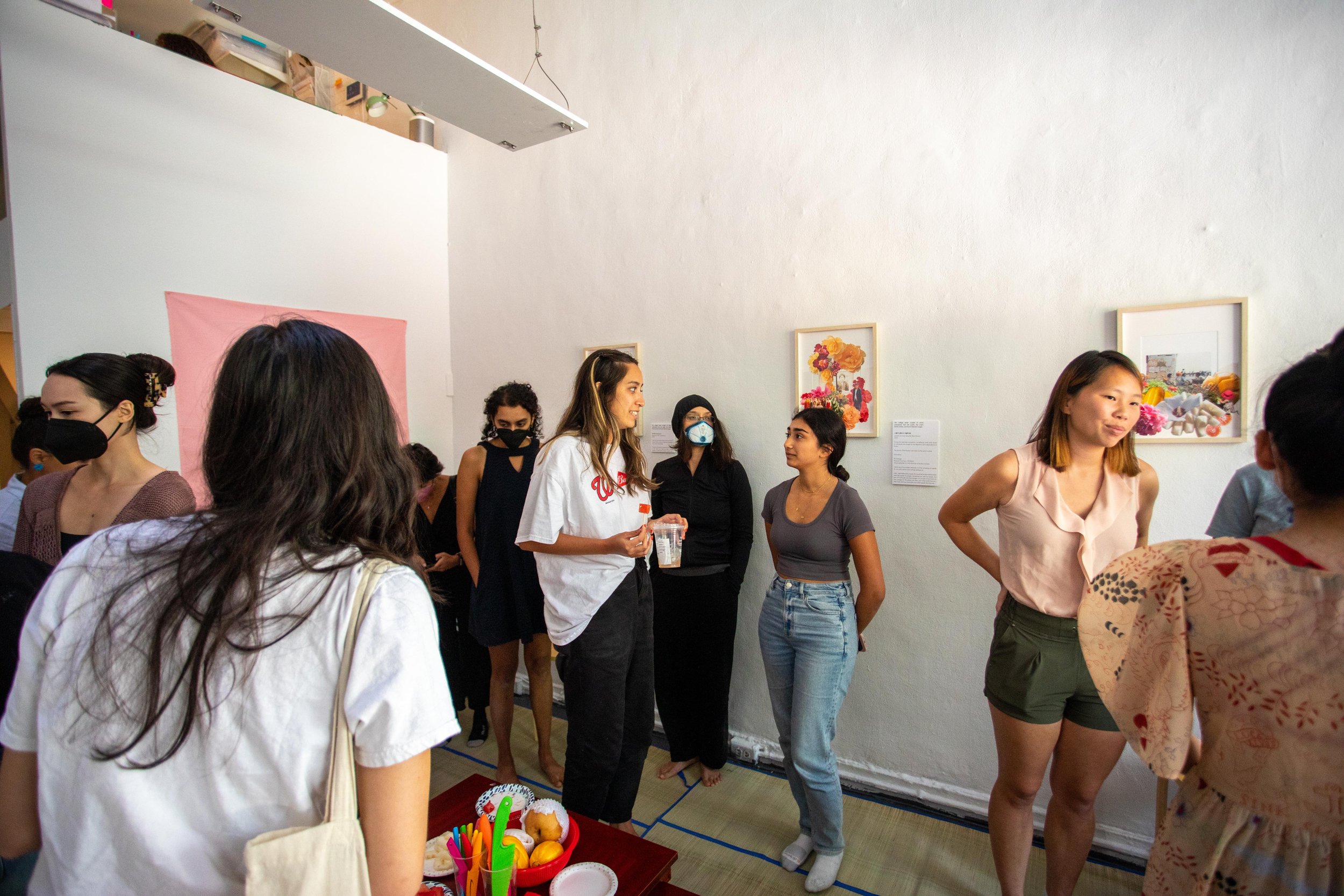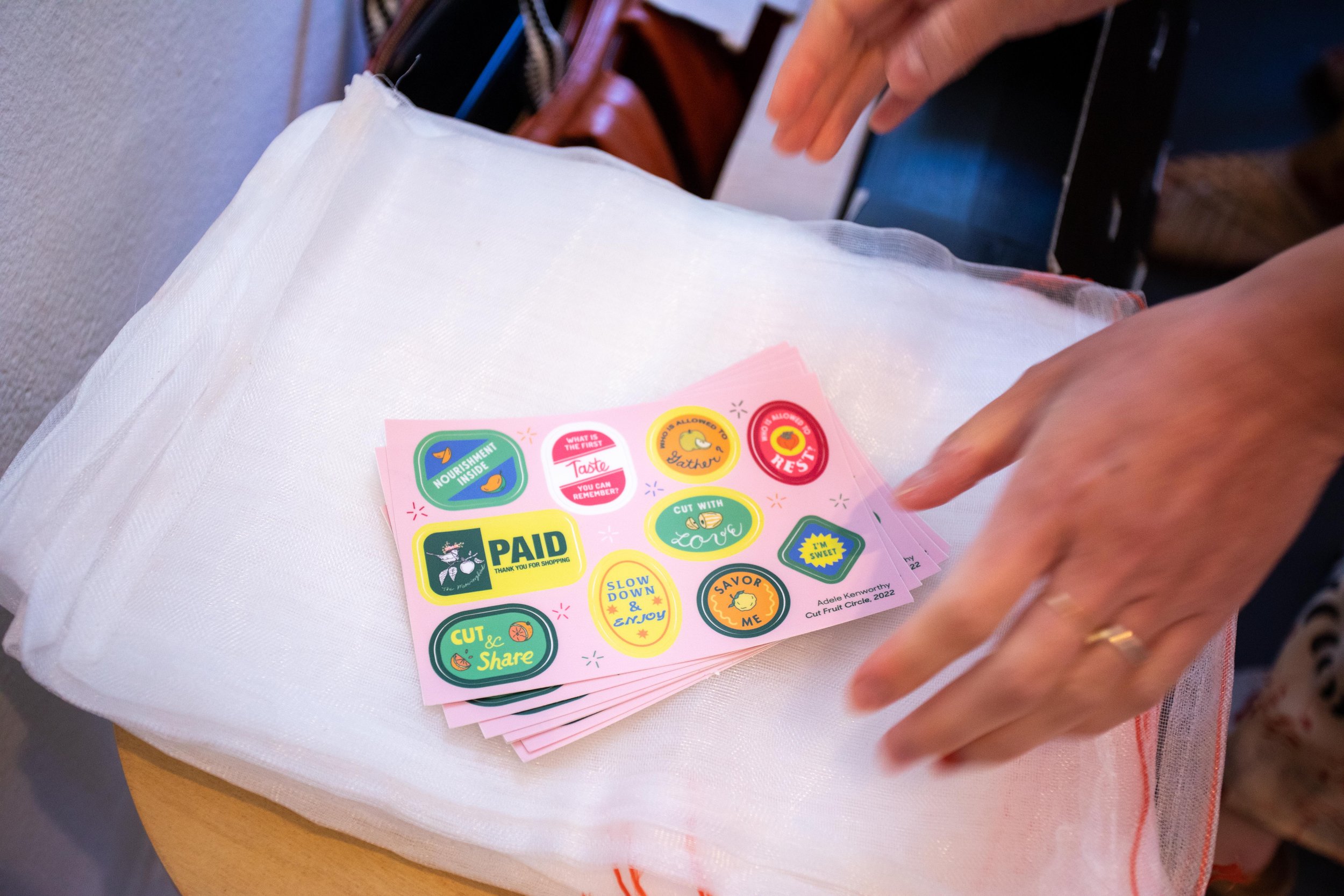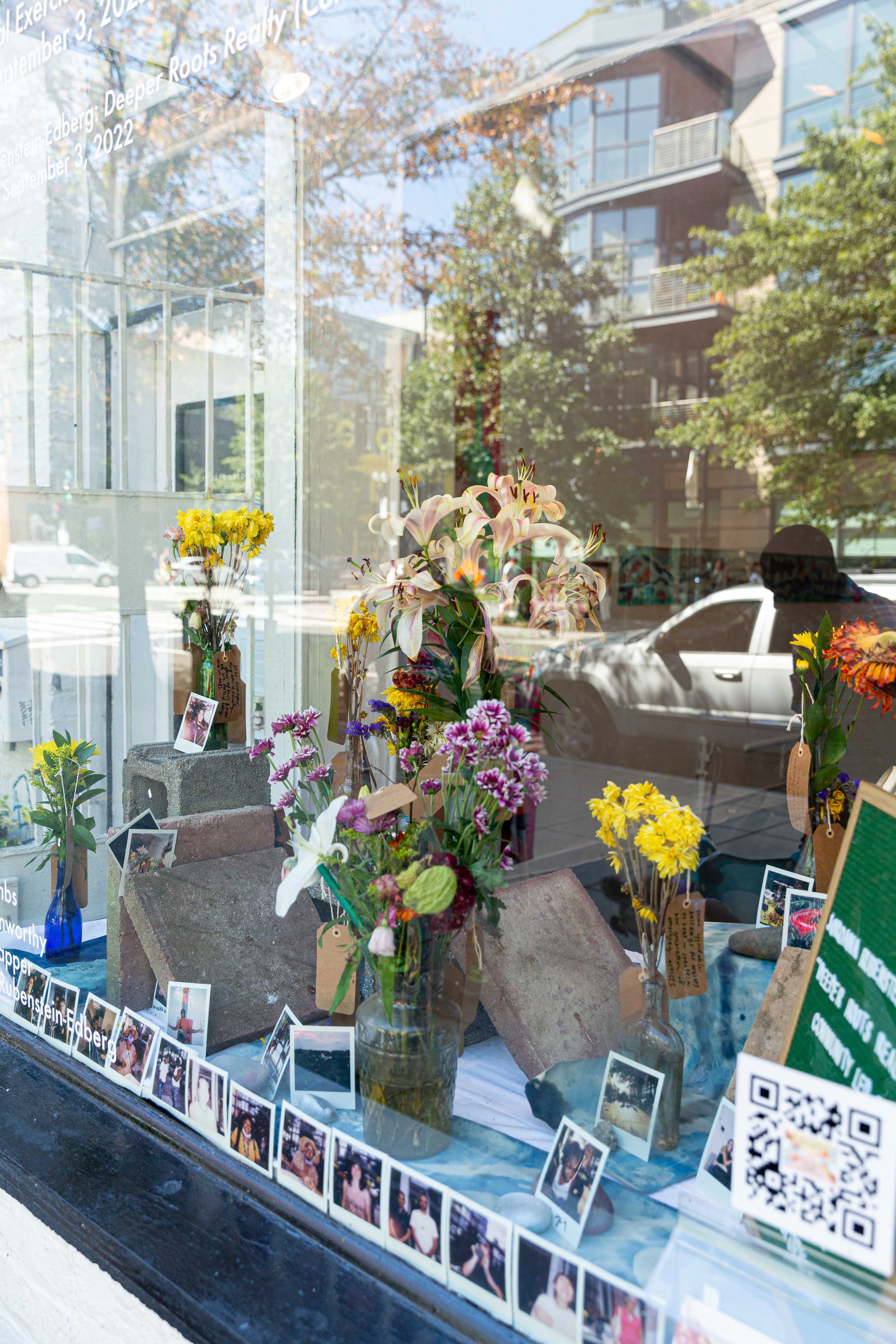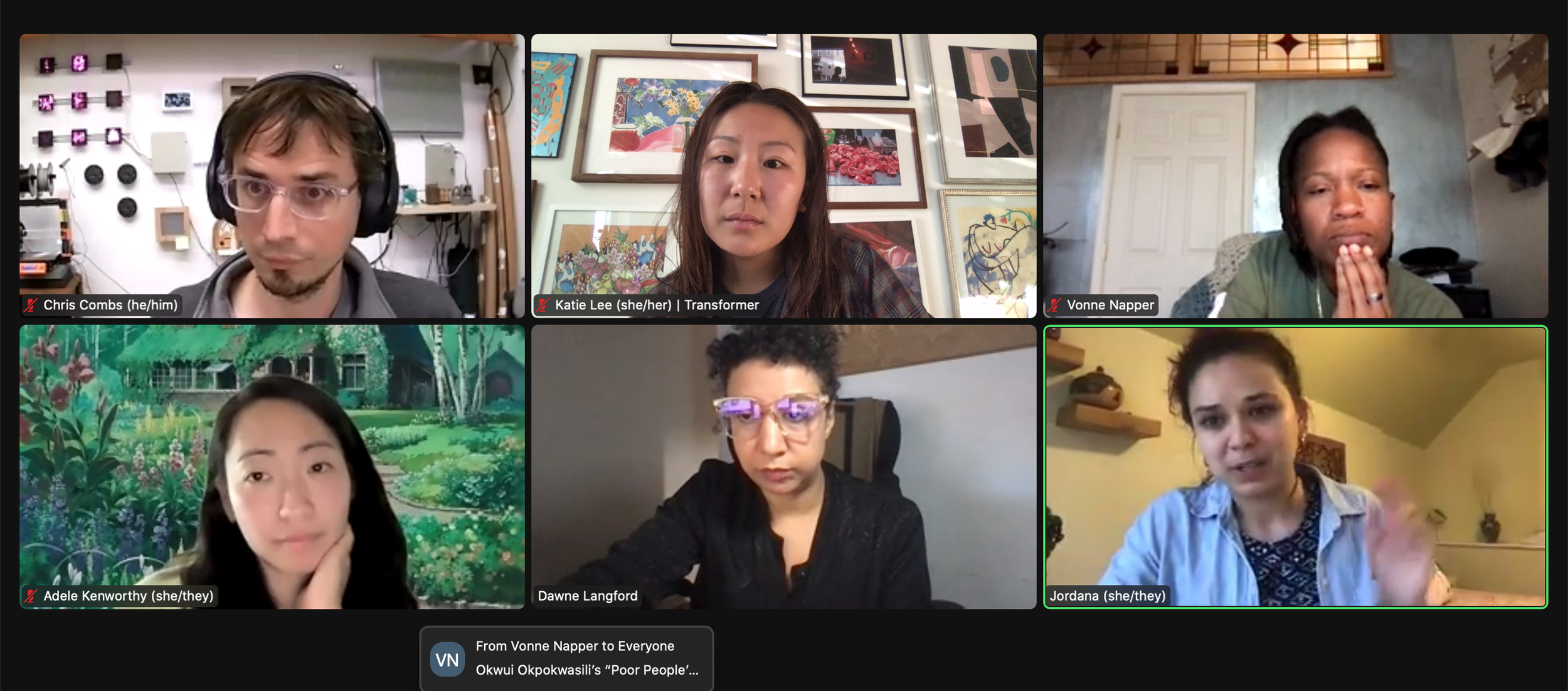E19: Artistic Interventions
Chris Combs, Adele Kenworthy, Vonne Napper, Jordana Rubenstein-Edberg
July 9 – September 3, 2022
E19: Artistic Interventions is the 19th year of Transformer’s Exercises for Emerging Artists program, bringing together an invited group of 4 emerging DC area-based artists for 2 months of rigorous peer mentorship (May - June), resulting in a summer exhibition at Transformer and in the public sphere. Focusing on a different artistic discipline each year, E19: Artistic Interventions artists explore artistic interventions in their myriad forms and interpretations. E19: Artistic Interventions was led by mentor Dawne Langford - an award-winning editor, documentary producer, and independent curator, and was curated and coordinated by Katie Lee, Transformer’s Exhibitions & Programs Manager. E19: Artistic Interventions artists received additional guidance and feedback from a series of guest mentors, including: Mel Chin, Monica Jahan Bose, Philippa Hughes, Mark Strandquist, and Naoko Wowsugi.
Exhibition Schedule:
Chris Combs: The Algorithm Will See You Now | July 9 – July 23, 2022
Vonne Napper: Choose Your Gender | July 27 – August 6, 2022
Adele Kenworthy: to carry within us an orchard | August 10 – August 20, 2022
Jordana Rubenstein-Edberg: Deeper Roots Realty (Community Led Design) | August 24 – September 3, 2022
E19: Artistic Interventions Project Details + Artist Bios:
Chris Combs: The Algorithm Will See You Now
July 9 – July 23, 2022
Opening Reception: Saturday, July 9, 4-7pm
In The Algorithm Will See You Now, artist Chris Combs uses interactive electronics to ask pressing questions about algorithmic injustice and surveillance capitalism.
Machine learning or "artificial intelligence (AI)" tools are popping up like mushrooms after a rain. They are trained—like a puppy—from massive datasets of human decisions, such as, this photo depicts a cat, or, we granted parole to a person with this name and this criminal record.
In this way, countless amounts of individual decisions made by people are then laundered into an "algorithm" that is empowered to make decisions itself. Despite being automated and performed by a machine, there is nothing that inherently makes these decisions objective. An AI's training is rarely known to the public. What are the implications of this, and what can we do about it?
Chris Combs is an artist based in Washington, D.C and Mount Rainier, Maryland who creates provocative technology. His Lossiness at VisArts featured seven artworks exploring the boundaries of human perception. Judging Me Judging You at the DC Arts Center explored themes of surveillance and control, and his installation Maelstrom at Rhizome DC featured 35 machines spreading rumors about its visitors. Madness Method, a public art collaboration with David Greenfieldboyce, was part of Georgetown GLOW.
Chris is a two-time recipient of the DCCAH Arts and Humanities Fellowship program and was shortlisted for the 2021 Aesthetica Art Prize. He is a graduate of the Corcoran College of Art + Design and was a photo editor for National Geographic. He joined the Otis Street Arts Project in May, 2021.
The Algorithm Will See You Now Installation Images and Opening Reception:
Chris Combs, Illegal in Illinois, 2022
Installation View, "The Algorithm Will See You Now." Image courtesy of Transformer
Installation View, "The Algorithm Will See You Now." Image courtesy of Transformer
Installation View, "The Algorithm Will See You Now." Image by Catie Leonard
Installation View, "The Algorithm Will See You Now." Image by Catie Leonard
Installation View, "The Algorithm Will See You Now." Image by Catie Leonard
Installation View, "The Algorithm Will See You Now." Image by Catie Leonard
Installation View, "The Algorithm Will See You Now." Image by Catie Leonard
Installation View, "The Algorithm Will See You Now." Image by Catie Leonard
Installation View, "The Algorithm Will See You Now." Image courtesy of Transformer
Installation View, "The Algorithm Will See You Now." Image by Catie Leonard
Opening Reception of "The Algorithm Will See You Now." Image courtesy of Transformer
Opening Reception of "The Algorithm Will See You Now." Image courtesy of Transformer
Opening Reception of "The Algorithm Will See You Now." Image courtesy of Transformer
Opening Reception of "The Algorithm Will See You Now." Image courtesy of Transformer
Opening Reception of "The Algorithm Will See You Now." Image courtesy of Transformer
Opening Reception of "The Algorithm Will See You Now." Image courtesy of Transformer
Vonne Napper, Choose Your Gender, 2022
Vonne Napper: Choose Your Gender
July 27 – August 6, 2022
Opening Reception: Sat., July 30, 2–4pm
Have you ever wondered what life would've been like had you been given the opportunity to choose your gender? Not in the sense of simply stating how you identify, but being supported, uplifted, acknowledged, believed, and seen while you navigated this journey called life as the person you know yourself to be. In essence, and in regards to society, the practice of choosing your gender is uncannily synonymous with choosing your battle. Do I continue to live a life performing trauma-inflicting behaviors stemming from the gender and the role that was placed on me? Or, do I make my gender expansiveness more visible at the possibility of facing more discrimination, oppression, and microaggressions, but also experiencing more love, self-worth, and community?
The power of choice, in general, is a privilege not all people are afforded, or something that everyone is aware that they may have. Before being born, a child’s inherent power to choose how they feel inside or whether they’re a girl or boy, both, or neither, is stripped from them, and from that point on their self-expression has the potential to feel staged.
Choose Your Gender is a testament to living a life out loud after silencing myself for years based on others’ expectations of my body. It is a charge to take control of your own narrative when you feel it’s time. It is the opportunity to expand your mind and critique your perception of gender and sexuality in the scope of social justice. And it is the demand to dismantle gender-based roles and discriminatory policies that are set up to oppress nonbinary and trans people.
As part of this exhibition, the artist invited the public to submit responses reflecting on their gender. You can view all submissions here.
Vonne Napper is a Black queer interdisciplinary artist born and raised in Washington, D.C. As a child they displayed great interest in learning new things, often floating from one interest to the next. Consequently, their art practice spans various mediums including printmaking, graphic design, videography, painting, writing, and fibers. Deriving influence from artists Jeffrey Gibson, James Baldwin and Audre Lorde, their practice centers social justice, new age healing, and preserving the black queer experience. As a Black person that identifies as nonbinary and trans-masculine, Vonne pulls from their lived experience to highlight the challenges of existing at a particularly targeted intersection and employs their spirituality along with metaphysics to establish connections between the communities to which they belong. Vonne’s artistic philosophy suggests that our reality is an interrelated one and the more we choose to accept our natural diversity and respective needs, the greater the outcome for collective transformation and social change. With their powerful ability to adapt to numerous environments and situations paired with their spirited curiosity, Vonne considers the way they approach their art practice synonymous with how they approach life - cultivating relationships with several mediums as they do with individual people in order to discover something within themselves. They navigate the art world and society with genuine intent and the unwavering belief that art can evoke introspection and healing, especially when practiced in collaboration with others.
www.vonnenapper.com / @vonnenapperstudio
Choose Your Gender Installation Images and Opening Reception:
Installation View, "Choose Your Gender." Image by Farrah Skeiky.
Installation View, "Choose Your Gender." Image by Farrah Skeiky.
Installation View, "Choose Your Gender." Image by Farrah Skeiky.
Installation View, "Choose Your Gender." Image by Farrah Skeiky.
Installation View, "Choose Your Gender." Image by Farrah Skeiky.
Installation View, "Choose Your Gender." Image by Farrah Skeiky.
Installation View, "Choose Your Gender." Image by Farrah Skeiky.
Installation View, "Choose Your Gender." Image courtesy of Transformer.
Installation View, "Choose Your Gender." Image by Farrah Skeiky.
Installation View, "Choose Your Gender." Image by Farrah Skeiky.
Opening Reception of "Choose Your Gender." Image courtesy of Transformer
Opening Reception of "Choose Your Gender." Image courtesy of Transformer
Opening Reception of "Choose Your Gender." Image courtesy of Transformer
Opening Reception of "Choose Your Gender." Image courtesy of Transformer
Opening Reception of "Choose Your Gender." Image courtesy of Transformer
Opening Reception of "Choose Your Gender." Image courtesy of Transformer
Adele Kenworthy: to carry within us an orchard
August 10 – August 20, 2022
what is the first taste you can remember?
to carry within us an orchard, a line from Li Young Lee’s From Blossoms, is a poem that celebrates community at every point of connection. As a first generation American with immigrant parents – in all the language and cultural divides that separated us – this exhibition explores the embodied gestures and rituals of care that fill the silences between us. In this space of transnational cultural memory, as a femme presenting Asian American, Kenworthy brings cut fruit to Transformer as an intervention in this country’s landscape of care as a commodity.
Growing up there was a moment in my life where the dominant language shifted from Korean to English — I don’t know exactly when that happened but I do know that for a period of time I was very confused.
And during this time my mom, my brother and I lived in hiding in a women’s shelter for two years. I was too young to understand what that meant, but I was old enough to remember.
The only way she was able to share love and light to me was on our walks (which I thought were just strolls, but were really her starting her life over) she’d pick the wildflowers alongside the road and adorn me in this floral jewelry.
I think a lot about inheritance — things and practices I should’ve inherited and the ones I did — and my hope in my practice is to continue creating spaces in public where counter memories can exist and flourish.
During this time with Transformer I’ve been really thinking about what has care looked like in my life? Embodied?
The tattoo on my arm is of a persimmon branch – not only is it my favorite fruit – it’s actually the first taste I can remember.
I have the first generation immigrant mom — in all our language and cultural barriers — we didn’t verbally say I love you — but I grew up with gestures like cut fruit, folded laundry, odd objects that might be useful only if you have a specific habit (e.g., small folding lap desk).
Even in Ocean Vuong’s new collection of poems Time is a Mother one poem he wrote is simply the list of items in his mom’s Amazon cart a few months before she passed, which he titled “Amazon history of a former nail salon worker.”
And it was a mix of small things she’d need but also, always an item someone else she loved needed.
Toni Cade Bambara, an artist activist in the 70s said, The role of the artist is to make revolution irresistible.
So I want to bring cut fruit to Transformer.
There are days I’ll be there cutting fruit for passersby, especially for those who choose to rest on the bench in front of the gallery.
There will be a day (or days) I’ll invite asian american femme care workers and artists in the DC Metro area and host a fruit cutting circle. Where we can gather, cut some fruit for one another and share “cut fruit” stories — gestures and rituals of care given and received.
Instead of price per pound signs, there will be questions asking (mostly questions I’ve asked my parents throughout my life):
what is something you always wished I had asked and knew about you?
if we met when we were kids, would we have been friends?
what is the first taste you can remember?
what fruit carries the most memories?
who is allowed to gather?
who is allowed rest?
Adele Kenworthy (she/they) is a socially engaged artist organizer who creates botanical interventions in public spaces. They explore how flowers have dyed, draped, and nourished social movements and daily reimagine what it means for socially engaged art to exist as an embodied practice of care. They were selected to be among WomenPhotograph’s first BIPOC visual storytellers open call in 2021. They have recently exhibited work for The Fearless Artist Popup Gallery at Art Basel Miami (2021), TREEHOUSE at Brentwood Arts Exchange (2022), and their solo thesis show Lacuna Blossoms at Gallery 102 of George Washington University (2022).
They are currently the artist-organizer in residence at the Washington Project for the Arts and are participating in their 41st annual benefit auction. They recently earned their MFA in Social Practice Art from the Corcoran School of Art and Design. This summer they will be supporting Monument Lab and their newly launched Re:Generation program – a nationwide participatory public art and history project. Her art practice and community is located on the traditional lands of the Piscataway and Nacotchtank (Anacostan) people, also referred to as Washington, D.C.
themeowingbird.com / @themeowingbird
to carry within us an orchard Installation Images and Opening Program:
Image Credit: Ariana Arenius, 2022
Images by Mariah Miranda
Jordana Rubenstein-Edberg, GENTRIFICATION IS NOT NEW GENTRIFICATION IS NOT INEVITABLE GENTRIFICATION IS NOT NEW, 2022
Jordana Rubenstein-Edberg: Deeper Roots Realty (Community Led Design)
August 24 – September 3, 2022
Deeper Roots Realty is a community led design company seeking to collaborate with DC community members through collective storytelling and re-mapping of our city. We wonder: What if community members designed the neighborhood? What if economic displacement wasn't the cornerstone of "growth"? How can local communities reinvest in our gentrification-strewn city? What does gentrification even mean? To start off, Deeper Roots is opening the doors at Transformer Gallery for open storytelling sessions from August 24 - September 6th, from 12 to 6 pm. Come through to participate in community map making and story sessions. Tell us, what should people know about the neighborhood that is often overlooked?
Jordana Rubenstein-Edberg is a multi-disciplinary artist focused on creating spaces for community dialogue. Born and raised in the DC area, art and social movements have always been intertwined for Rubenstein-Edberg. They are a social practice visual artist and documentary filmmaker who works alongside policy makers and community organizers to create social change. Because they collaborate with people and work in community spaces, the creative process is just as important as the artwork created.
Growing up in a youth art program at the Atlas Performing Arts Center, they saw the power of storytelling to shift perceptions, build relationships, and create unity from fragmentation. Following in this path, they have co-created visual art pieces with undocumented artists living in deportation centers in New York, families seeking asylum in Berlin, artists in the New York City incarceration system, and middle school students in the South Bronx, among others. In 2017, Rubenstein-Edberg received the Thomas J. Watson Fellowship, an annual research grant awarded to 40 people across the U.S. During this time, they collaborated with a variety of indigenous storytellers in Central and South America, as well as India, who taught them how visual storytellers can uphold histories that are systematically oppressed.
As a recent MFA Social Practice graduate from the Corcoran School of Art and Design at the George Washington University, Rubenstein-Edberg created the multimedia project (Un)Natural Divides which explores the different conceptions of safety and belonging in Washington D.C as well as The Body Spectrum, a documentary exploring how the gender spectrum opens the door for people of many experiences and body types to be seen, heard, and loved. As part of my thesis project, they are releasing The Joyful Scar, a photography book documenting my own and others experiences receiving double mastectomies for breast cancer prevention. Following their time at the Corcoran School of Art and Design, they are excited to create with their own production company, UnderstoryDocs.
www.jordanamedia.com / @jordanamedia
Deeper Roots Realty (Community Led Design) Installation Images:
Images by Farrah Skeiky
Deeper Roots Realty (Community Led Design) Programming Images:
Opening Reception, image courtesy of Transformer
Opening Reception, image courtesy of Transformer
Opening Reception, image courtesy of Transformer
Artist Talk, image courtesy of Transformer
Artist Talk, image courtesy of Transformer
Artist Talk, image courtesy of Transformer
"Dear Developer" program, image courtesy of Transformer
"Dear Developer" program, image courtesy of Transformer
Music Concert & Advocacy Conversation, image courtesy of Transformer
Music Concert & Advocacy Conversation, image courtesy of Transformer
E19: Artistic Interventions Lead and Guest Mentor Bios:
Dawne Langford is a documentary producer and cultural producer. After years of working in public media as a broadcast television editor, she transitioned to producing. In 2013, Dawne was accepted to the PBS Producers Academy and began working on independent documentaries, including; Check It, Kandahar Journals, and Finding Joseph I. Recently, Dawne worked in New York City as a story producer with Lee Hirsch and is currently producing Untitled Baltimore Documentary Project, chronicling the election and first year of Baltimore Mayor Brandon Scott. In addition to documentary work, Dawne Langford is interested in artist movements that are firmly rooted in the power of the collective. Recent projects include collaborating with artist Mel Chin collective G.O.N.G. (Gathering Of Noetic Generation) on the project WAVE, a poetic expression of gratitude in collaboration with Times Sq Arts Alliance/For Freedoms, a special SPRING/BREAK presentation of Vanishing Points, with artist Rachel Schmidt, presented work with artist Alejandro Pintado for the Smithsonian and curated works from Rafael Lozano-Hemmer to be in displayed in Athens, Greece in June 2022.
Monica Jahan Bose is a Bangladeshi-American artist and climate activist whose work spans painting, printmaking, film, performance, and public art. Her socially engaged work highlights the intersection of climate, racial, gender, and economic injustice through co-created workshops, art actions, and temporary installations and performances. Bose uses the sari — a precolonial 18-foot-long unstitched garment that is always recycled and never discarded — to represent women’s lives and the cycle of life on our planet. She has exhibited her work extensively in the US and internationally (20 solo shows, numerous group exhibitions, and more than 25 performances) including solo exhibitions at the Bangladesh National Museum and MACRO Museum of Contemporary Art Rome. Her ongoing collaborative project STORYTELLING WITH SARIS with women farmers from her ancestral island village has travelled to 10 states and five countries and engaged thousands of people. She has a BA in the Practice of Art (Painting) from Wesleyan University, a post-graduate Diploma in Art from Santiniketan, India, and a JD from Columbia Law School.
Mel Chin was born in Houston, Texas and is known for the broad range of approaches in his art, including works that require multi-disciplinary, collaborative teamwork and works that enlist science as an aesthetic component to developing complex ideas. He created and implemented Revival Field (1990), a project that was a pioneer in the field of “green remediation,” the use of plants to remove toxic, heavy metals from the soil. From 1995-1998 he formed the collective the GALA Committee that produced In the Name of the Place a public art project conducted on American prime-time television. Chin is one of the artists featured in the first year of the ongoing PBS Series Art of the 21st Century. His proposal for a New World Trade Center was part of the American representation at the 2002 Venice Biennale of Architecture. In 2017 his film, 9-11/9-11, won the Pedro Sienna Award for Animation in Chile. His ongoing Fundred Project addresses childhood lead-poisoning through art-making. In 2018 he presented Unmoored and Wake in Times Square, New York City, creating a visual portal into a future of rising waters and concurrently he had a 40-year-survey exhibition at the Queens Museum, NYC, that Hyperallergic, the online arts magazine, named the best art exhibition of 2018. He is the recipient of many awards, grants, and honorary degrees, including the MacArthur Fellowship, 2019, and election to the The American Academy of Arts and Letters, 2021.
Philippa P.B. Hughes is a Social Sculptor and Creative Strategist who designs relational spaces for honest and transformative conversations across political, social, and cultural differences. She has produced hundreds of creative activations since 2007 for people who might not normally meet to engage with one another in unconventional and meaningful ways. These relational experiences build social capital, social cohesion, and social discourse. Her practice encompasses a multi-disciplinary approach informed by sociology, psychology, philosophy, political science, history, community organizing, design thinking, creative placemaking, art, and humanities. Philippa has spoken at TEDxAmericanUniversity, University of Michigan's Penny Stamps Speaker Series, Fort Worth Women's Policy Forum. Her work has been featured by CNN, PBS Newshour, CityLab, The Washington Post, among other media outlets. Philippa’s mission: to create a society in which all humans flourish.
Mark Strandquist (he/him) has spent over a decade using art to amplify, celebrate, and power social justice movements.The immersive exhibitions and multimedia projects he directs have helped advocates close a youth prison, pass laws, train police officers, and connect the dreams and demands of communities impacted by the criminal justice system with tens of thousands of people. His work has been exhibited in museums, galleries, and universities, as well as through parades, church-basement legal clinics, and illegal wheatpaste installations. He has received multiple awards, fellowships, national residencies, and reached wide audiences through the NY Times, the Guardian, NPR, the Washington Post, PBS, VICE, and many others. He founded, and currently co-directs the Performing Statistics project in Richmond, VA, and, through fellowships from A Blade of Grass and Open Societies, co-directs the People’s Paper Co-op and Reentry Think Tank with his partner Courtney Bowles.
Naoko Wowsugi is an artist of Korean-Japanese descent, based in Washington, D.C. Using combined practices of visual art, local research, and community participation, Wowsugi’s projects highlight and fortify everyday communal and interpersonal identities.







